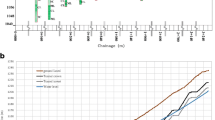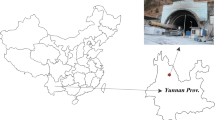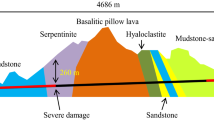Abstract
An approximately 2-km-long tunnel is located in the heart of the Bailadila hills in India and is used for the transportation of iron ore excavated from nearby mines. A portion measuring 2 m height and 5 m width of the Reinforced Cement Concrete (RCC) wall of this tunnel was severely ruptured and caved in bringing a lot of debris and the slush. This caused subsidence on the hilly terrain surface exactly overlying the affected tunnel portion. Various stabilization measures consisting of cement grouting in tandem with chemicals were undertaken to strengthen the failed concrete lining as well as the rock and soil mass of tunnel walls and roof in and around the collapsed portion. Additional stabilization measures were also undertaken to back-fill the cavity/pothole formed on the hilly terrain surface. Further, monitoring of the stabilized zone was carried out by installing mechanical type convergence indicators in the tunnel walls and roof. Also, the efficacy of grout was estimated using an ultrasound sonic tester and through Schmidt hammer rebound tests. The paper presents this case study along with the conclusions and recommendations, which were drawn based on this study.





Similar content being viewed by others
References
Bagde MN (2016) Characterization of failure modes and planned stabilization measures for the Ajanta caves in India. Int J Rock Mech Min Sci 81:12–18
Bagde MN (2021) Assessment of rockfall hazard and stabilization of rock slope surface at the World Heritage Ajanta cave. Geotech Geol Eng 39:3101–3114
Bagde MN, Kumar A, Jha BK, Kiran S, Chakraborty AK (2008) Stabilizations of the collapsed portion of the tunnel wall and pothole on the surface of the tunnel—Bailadila Iron Ore Project, NMDC: a case study. In: Gupta M., Chitra R., Sharma K. G. (Eds) Geo-Symposium 2008—National Symp on Geo-environment, Geo-hazards, Geo-synthetics and Ground Improvement-Experiences and Practices (4G), CSMRS N. Delhi, July 4–5, pp 267–274
Bagde MN, Sangode AG, Jhanwar JC, Buragohain J, Kumar A (2019) Strata control problems encountered and support designing in one of the incline tunnel while driven in coal measure rocks. In: Proceedings in Earth and Geosciences, Vol 6—Rock Mechanics for Natural Resources and Infrastructure Development, 13–18 Sept 2019, Iguassu Falla-Brazil, Organized jointly by ISRM, ABMS, CBMR, SAIG & SPG, Sergio A B da Fontoura, Ricardo Jose Rocca & Jose Povon Mendoza (Eds), Vol. VI, 403–409. ISBN 978–0–367–42284–4. CRC Press, Taylor & Francis Book, A Balkema Book
Bagde MN, Soni AK, Sinha A (2010) Stabilization and seepage control measures suggested at 100 yrs. Old Parsik tunnel of Central Railways. In: International Conference on Underground Constructions Prague 2010—Transport and City Tunnels, 14–16, June 2010, Prague, Czech Republic
Barton N, Lien R, Lunde J (1974) Engineering classification of rock masses for the design of tunnel support. Rock Mech 6:189–236
Bieniawski ZT (1989) The geomechanics classification in rock engineering applications. In: Proceedings of 4th congress of the international society for rock mechanics
Cambefort H (1977) The principles and applications of grouting. Q J Eng Geol 10:57–95
CIMFR Report (2007) Advice on stabilisation of collapsed portion of the tunnel wall and pothole on the surface and unlined portion of the tunnel carrying conveyor No. 29, Bailadila iron ore project, NMDC. CIMFR unpublished report. December 2007
Houlsby AC (1982) Optimum water:cement ratio for rock grouting. CGGE, New Orleans, pp 317–331
Indian Standard: IS 4880 (Part II) (1976) Code of Practice for design of tunnels conveying water: Part II-Geometric Design
Indian Standard: IS 4880 (Part VI) (1971) Code of Practice for design of tunnels conveying water: Part VI-Tunnel Supports
Indian Standard: IS 4880 (Part IV) (1971) Code of Practice for design of tunnels conveying water: Part IV-Structural Design of Concrete Lining in Rock
Indian Standard: IS 4999 (1968) Recommendations for Grouting of Pervious Soils
Indian Standard: IS 5878 (Part V) (1976) Code of Practice for construction of tunnels conveying water: Part V-Concrete Lining
Indian Standard: IS 5878 (Part VII) (1972) Code of Practice for construction of tunnels conveying water: Part VII-Grouting
Indian Standard: IS 2720 (Part 13) (1986) Method for test for soils. Part 13—Direct shear test. 2nd Revision, Bureau of Indian Standards
Indian Standard: IS 2720 (Part 4) (1985) Method for test for soils. Part4—Grain size analysis. Bureau of Indian Standards
ISRM Standard (1996) International Society for Rock Mechanics Commission on Rock Grouting. Int J Rock Mech Min Sci Geomech Abstract 33(8):803–847
Karol RH (2003) Chemical grouting and soil stabilization. Marcel Dekker, Inc Publication, p 558
Krizek RJ, Perez T (1985) Chemical grouting in soil permeated by water. JGE ASCE 111(7):898–915
Krsmanovic D, Langhof Z, Zupcevic H (1969) Prestressing the lining of a hydroelectric tunnel in a watertight rock by grouting. Rock Mech Springer Wien 1(1):71–86
Nonveiller E (1989) Grouting theory and practice. Elsevier publication, 250
Singh B, Goel RK (1999) Rock mass classification- a practical approach in civil engineering. Elsevier publication, p 266
Stillborg B (1986) Professional users handbook for rock bolting. Trans Tech Publications, p 145
Szechy K (1967) The art of tunneling. Akademiat Kiado, Budapest, p 891
Acknowledgements
Thanks are due to M/s NMDC Ltd, India, for sponsoring this study. The authors are thankful to the Director, CSIR-CIMFR for his kind permission to publish this paper. Sincere thanks are due to Late (Dr) A. K. Chakraborty for his guidance during the course of the study. Thanks are also due to former colleagues, Mr. B. K. Jha and Mr. S. Kiran for their support during the study. The opinions expressed in this paper, if any, are those of the author's and not necessarily of the institute they belong to.
Author information
Authors and Affiliations
Corresponding author
Ethics declarations
Conflict of interest
On behalf of all authors, the corresponding author states that there is no conflict of interest.
Rights and permissions
About this article
Cite this article
Bagde, M.N., Kumar, A., Kumbhakar, S. et al. The tunnel wall collapse and pothole creation on the hilly terrain surface: a case study of stabilization. Innov. Infrastruct. Solut. 7, 29 (2022). https://doi.org/10.1007/s41062-021-00617-7
Received:
Accepted:
Published:
DOI: https://doi.org/10.1007/s41062-021-00617-7




